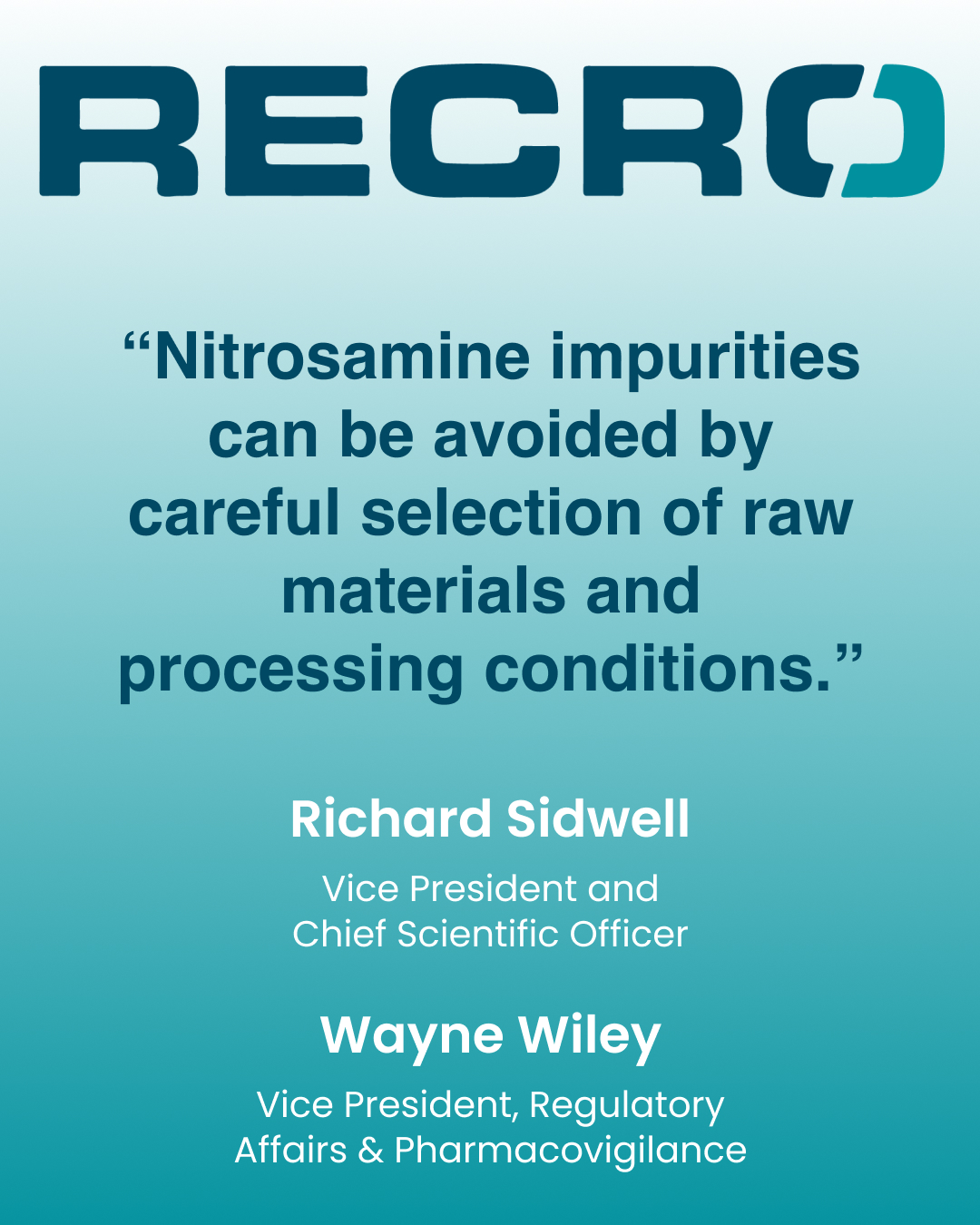
#SpeakPharma with Recro
2021-05-21
Impressions: 4082
Since 2018, several drug products, including angiotensin II receptor blockers (ARBs), ranitidine, nizatidine and metformin, have been found to contain unacceptable levels of nitrosamines. The presence of nitrosamines has been confirmed by several regulators, including the US Food and Drug Administration (FDA) and the European Medicines Agency (EMA), prompting them to recall and withdraw certain batches of these drugs and also issue safety alerts.
This week, we speak to Richard Sidwell, Vice President and Chief Scientific Officer, and Wayne Wiley, Vice President, Regulatory Affairs and Pharmacovigilance, at Recro, on the steps pharmaceutical companies need to take to assess and mitigate risks from nitrosamine impurities. Recro is a contract development and manufacturing organization (CDMO) with expertise in solving complex manufacturing problems. Recro provides oral solid dosage form development, end-to-end regulatory support, clinical and commercial manufacturing, and packaging and logistics services to the global pharmaceutical market.
What are nitrosamines? And how do they harm us?
Richard Sidwell: Nitrosamines are a class of compounds having the chemical structure of a nitroso group bonded to an amine (R2N-N=O where R is usually an alkyl group). Nitrosamines are recognized as probable human carcinogens, and five of them (NDMA, NDEA, NMBA, NIPEA, and NMPA) have been detected in active pharmaceutical ingredients (APIs) or drug products.
The discovery of nitrosamines in some types of drug products led the FDA and other international regulators to conduct a detailed analysis of these impurities in affected APIs and drug products. Nitrosamine impurities have been found in some drug products, and many batches of these products have been recalled where unacceptable levels of these impurities had been detected. However, nitrosamine impurities might exist in other APIs and drug products as well, due to the use of processes and materials that are conducive to the formation of these organic compounds.
What conditions can lead to the presence of nitrosamines?
Richard Sidwell: Nitrosamine impurities can form by a nitrosating reaction between amines (secondary, tertiary, or quaternary amines) and nitrous acid (nitrite salts under acidic conditions). Both high temperatures and low pH contribute to nitrosamine formation. In API manufacturing, one must consider all starting materials, intermediates, reagents, and solvents because residual amounts of these materials may carry over into subsequent steps. These residual materials are susceptible to all subsequent processing conditions in the final API steps and the manufacturing of the drug product. It is important to consider that it’s not just the chemistry between the intended raw materials that should be assessed but also the possibility of impurities within each raw material. In some cases, nitrosamine impurities were traced to impurities present in recycled solvent used in the API manufacturing process.
Is there any guidance from health authorities on nitrosamines?
Wayne Wiley: Yes, there are numerous guidance documents that have now been published on detection, control and regulation of nitrosamines. I have listed the more notable guidance documents below:
- FDA – Control of nitrosamine impurities in human drugs
- EMEA – Nitrosamine impurities
- Health Canada – Nitrosamine impurities in medications: Overview
Each of these guidance documents provide specific details about acceptable levels, possible sources of nitrosamine impurities, how they can be formed, possible ways to mitigate, and recommendations for steps to take and appropriate timings thereof.
What can companies do, as a first step, to deal with the potential for nitrosamine impurities in their commercial products?
Wayne Wiley: The FDA guidance recommends performing an immediate risk assessment with respect to the potential presence or formation of nitrosamines in all FDA-approved pharmaceutical products. At a high level, this involves assessing all raw materials for the possible presence of nitrosamine impurities and the presence of impurities/moieties that could contribute to the formation of nitrosamines within the finished product either during processing or on stability.
If this risk assessment indicates the possibility of nitrosamine presence or formation, the product should be tested to confirm the absence of such impurities. In light of the regulatory agency recommendations, contract lab nitrosamine testing capacity has been in high demand.
While planning, product sponsors should consider the potential for delays in testing to ensure availability of results within the recommended timelines. If testing confirms the presence of nitrosamine impurities, further steps to mitigate become imperative.
The FDA had recommended completion of the primary risk assessment within seven months of the original September 2020 guidance publication (i.e., by March 31, 2021). Confirmatory testing, if required, should begin immediately for products considered at high risk. Both confirmatory testing and submission of any required changes in drug applications for mitigation purposes should be concluded on or before October 1, 2023.
What does this mean for drug products that are still under development?
Richard Sidwell: Development programs should plan to submit nitrosamine assessments as part of the original filings, whether as a new drug application (NDA), abbreviated new drug application (ANDA), or a drug master file (DMF).
According to the guidance, the FDA recommends that applicants conduct both a risk assessment for nitrosamine impurities and confirmatory testing, if necessary, before the submission of an original application.
Wayne Wiley: The FDA may accept the filing of this information in an amendment during the review period if it is not available at the time of filing. However, this should be done quickly so as not to adversely impact the review timeline.
For products earlier in their development cycle, there is an important opportunity to avoid potential nitrosamine impurity concerns by careful selection of raw materials and processing conditions. Early risk assessment during excipient selection and formulation development can avoid the necessity of testing and possible complexity of downstream mitigation efforts and could be included in the original pharmaceutical development report.






